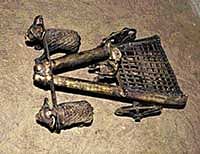Craft that defines Gond identity, tradition

Over centuries the Bharevas living in the predominantly tribal district of Betul, Madhya Pradesh, have honed and nurtured the craft of metal casting using the age-old filling method. Regarding themselves a sub-tribe of Gond tribe, spread across central India, the tradition of Bhareva metal craft is derived from and is an intrinsic part of the rituals and customs of the community.
The oral tradition handed down from one generation to the next is replete with mythology and stories of the origin of deities on earth. The objects of worship, the images of gods and goddesses they worship provides the artistic motivation, which then takes the form of metalwork, the origin of Bhareva art. The craftsmen are deeply influenced by the symbolic images of deities mainly Lord Shiva, one of the all-powerful Trinity in Hinduism, and his consort Parvati. The other enduring image is of Thakur Deo, who rides a miraculous horse and is supposed to protect village from calamities. There are other deities of peace, prosperity, happiness and health.
One of the most significant rituals is when a new couple approaches them to sculpt deities using the traditional craft. This is regarded as an imperative for any couple beginning life’s journey and deciding to live in a separate establishment. Without enshrining deities in their new home, this is incomplete and the importance of the role of the metal caster within the community becomes amply evident. It equals a blessing for the newly weds. The marriage ceremony of the Gonds itself is a testimony to this age-old craft. Ornaments like rings and daggers are essentials in the marriage rituals. The Bhagats or the spiritual heads of the community wear specially designed jewellery like wristlets and armlets.
The range includes numerous utility items like lamps, bells, mirror frames as well as decorative art pieces like bullock carts, peacocks, horses and elephants.
From the local to the global, the Bhareva art form rooted in Gond tradition and way of life, now has found its way, albeit in a limited way into the international craft market. Most of this has happened through state-sponsored craft fairs where the Bhareva artistes are invited to display their works. International art dealers scout such fairs and linkages are made for commissioning specific pieces.
Yet the Bharevas are conscious of a perceptible threat to their traditional art form. “First of all, the couples of Gond tribe have stopped wearing ornaments designed by us because of availability of comparatively affordable artificial jewellery. On the other hand, according to Sukhlal of Chuna Hujuri village, the cost of material for Bhareva jewellery has gone up phenomenally.
“Though, regular weekly markets in tribal pockets witness a brisk business, but sale of such art pieces is seasonal. Many alternatives are available, who will buy them ?” asks Mahesh Chandra Shandilya, programme officer with Madhya Pradesh Academy for Tribal Folk Arts, an autonomous body under department of culture, government of Madhya Pradesh. Craftsmen like Imrat Rawat of Sita Makat village for whom metal casting is the only means of livelihood are deeply concerned. “I have nothing but an ancestral house with less than half an acre patch. If Gond tribal families stop using the crafts items, I will have to think of other options,” he worries.
Today, surviving solely on casting skills, the craftsmen are shrinking in numbers. A little more than 50 families are settled in 10 villages in Betul district. Nearly 15 of these families still practice this unique art. “Many of us have already stopped the practice. Half a dozen households of Bharevas have turned into daily wage earners. They work either as farm labour or get work under Rural Employment Guarantee Scheme,” says Sahablal of Sita Kamat village.
There are others for whom the concerns are of a different nature. Acknowledging the trend of job openings and easy options available to Bharevas and the rigour of devoting oneself to a craft like metal casting, Sukhram, a distinguished metal-caster is equally concerned about the slow disappearance of this art form. It requires sophisticated artistry, which takes years of painstaking effort to acquire and sustain. Once they distance themselves from the process and practice, it takes years to regain mastery, says Sukhram.
Passionate about the craft, Sukhram’s family in the small village of Tigaria, including his son, Baldeo, are struggling to keep alive this tradition, which symbolises their identity over generations as Gonds. While many of their community members have got diverted into other livelihoods options, this family still keeps its efforts and hopes aloft. “I run a Bhareva Shilpa Kala Kendra at Betul for tribal children, but I am not sure of its sustainability,” says Baldeo. A drop in the ocean, perhaps but no doubt, commendable given the near-crises situation. It goes beyond a craft, a livelihood option for the Bharevas. It defines their identity, the flow of their traditions.
Deccan Herald is on WhatsApp Channels| Join now for Breaking News & Editor's Picks